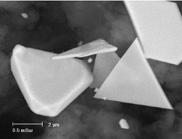Home > Press > CSIRO scientist discovers natural ‘invisible’ gold
 |
| Scanning electron microscope image of the gold triangles showing their well defined crystal shape. |
Abstract:
Nanoparticles of gold too small to be seen with the naked eye have been created in laboratories, but up until now, have never been seen in nature.
CSIRO scientist discovers natural ‘invisible’ gold
Australia | Posted on June 24th, 2008The search for these natural but ‘invisible' nanoparticles is important. If they can be proved to exist, the knowledge will help give us a deeper understanding of how gold can be transported and deposited by geological processes, and therefore help explorers to find new gold deposits in Australia.
Now, hard evidence that gold nanoparticles have finally been seen in nature is presented in a paper published in GEOLOGY and authored by CSIRO Scientists from the Minerals Down Under National Research Flagship and CRC LEME, in collaboration with scientists from Curtin University and the University of Western Australia.
Lead author, CSIRO's Dr Rob Hough, explains that the particles were discovered in Western Australia. "In the southern areas of the State, groundwater is very salty and acidic. This water dissolves primary gold and re-deposits it as pure gold crystals on fracture surfaces and in open pore spaces," he says.
"On investigation of these crystals, there appeared to be a dark band across them. However, high magnification imaging showed the band was in fact, a mass of gold nanoparticles and nanoplates. These are identical to those being manufactured in laboratories around the world for their unique properties."
Clays from the fracture surface were then analysed. There was no gold visible, but analysis showed the clays contained up to 59 parts-per-million of gold. The research team concluded that the nanoparticles of gold they had imaged represented the ‘invisible' gold in the clay, and that this nanosized gold was common in similar environments.
"The gold nanoparticles have not been identified earlier because they are transparent to electron beams and effectively invisible," Dr Hough says. "However, they are probably a common form of gold in this type of natural environment worldwide, where saline water interacts with gold deposits. They also provide the first direct observation of the nanoscale mobility of gold during weathering."
With gold fetching around (AU) $950 an ounce and expected to rise, this research is good news for Australia's gold explorers.
CSIRO initiated the National Research Flagships to provide science-based solutions in response to Australia's major research challenges and opportunities. The nine Flagships form multidisciplinary teams with industry and the research community to deliver impact and benefits for Australia.
####
About CSIRO Australia
CSIRO, the Commonwealth Scientific and Industrial Research Organisation, is Australia's national science agency and one of the largest and most diverse research agencies in the world.
For more information, please click here
Contacts:
Dr Rob Hough
Research Scientist
CSIRO Exploration & Mining
Phone: 61 8 6436 8763
Fax: 61 8 6436 8555
Copyright © CSIRO Australia
If you have a comment, please Contact us.Issuers of news releases, not 7th Wave, Inc. or Nanotechnology Now, are solely responsible for the accuracy of the content.
| Related News Press |
News and information
![]() Researchers develop molecular qubits that communicate at telecom frequencies October 3rd, 2025
Researchers develop molecular qubits that communicate at telecom frequencies October 3rd, 2025
![]() Next-generation quantum communication October 3rd, 2025
Next-generation quantum communication October 3rd, 2025
![]() "Nanoreactor" cage uses visible light for catalytic and ultra-selective cross-cycloadditions October 3rd, 2025
"Nanoreactor" cage uses visible light for catalytic and ultra-selective cross-cycloadditions October 3rd, 2025
Discoveries
![]() Researchers develop molecular qubits that communicate at telecom frequencies October 3rd, 2025
Researchers develop molecular qubits that communicate at telecom frequencies October 3rd, 2025
![]() Next-generation quantum communication October 3rd, 2025
Next-generation quantum communication October 3rd, 2025
![]() "Nanoreactor" cage uses visible light for catalytic and ultra-selective cross-cycloadditions October 3rd, 2025
"Nanoreactor" cage uses visible light for catalytic and ultra-selective cross-cycloadditions October 3rd, 2025
Announcements
![]() Rice membrane extracts lithium from brines with greater speed, less waste October 3rd, 2025
Rice membrane extracts lithium from brines with greater speed, less waste October 3rd, 2025
![]() Researchers develop molecular qubits that communicate at telecom frequencies October 3rd, 2025
Researchers develop molecular qubits that communicate at telecom frequencies October 3rd, 2025
![]() Next-generation quantum communication October 3rd, 2025
Next-generation quantum communication October 3rd, 2025
![]() "Nanoreactor" cage uses visible light for catalytic and ultra-selective cross-cycloadditions October 3rd, 2025
"Nanoreactor" cage uses visible light for catalytic and ultra-selective cross-cycloadditions October 3rd, 2025
|
|
||
|
|
||
| The latest news from around the world, FREE | ||
|
|
||
|
|
||
| Premium Products | ||
|
|
||
|
Only the news you want to read!
Learn More |
||
|
|
||
|
Full-service, expert consulting
Learn More |
||
|
|
||








